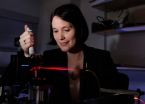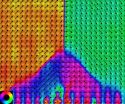(Press-News.org) A new laser technique has demonstrated that it can measure the interactions between proteins tangled in a cell's membrane and a variety of other biological molecules. These extremely difficult measurements can aid the process of drug discovery.
Scientists estimate that about 30 percent of the 7,000 proteins in a human cell reside in the cell's membrane and that these membrane proteins initiate 60 to 70 percent of the signals that control the operation of the cell's molecular machinery. As a result, about half of the drugs currently on the market target membrane proteins.
Despite their importance, they are difficult to study. . Individual membrane proteins are extremely hard to purify, so scientists have very little structural information about them. In addition, existing methods to measure their activity have serious limitations. Most existing assays remove the membranes from their natural environment or modify the membranes in a variety of different ways, such as attaching fluorescent labels, in order to analyze membrane protein activity.
"In addition to being expensive and time-consuming, these modifications can affect the target membrane's function in unpredictable ways," said Vanderbilt Professor of Chemistry Darryl Bornhop, who developed the new technique.
By contrast, in an article published online March 13 by the journal Nature Biotechnology, Bornhop's research group and their collaborators at The Scripps Research Institute, report that the laser-based technique, called backscattering interferometry (BSI), can precisely measure the binding force between membrane proteins and both large and small molecules in a natural environment.
"This is a powerful tool and a major advance in measuring membrane protein interactions," said Lawrence Marnett, director of the Vanderbilt Institute of Chemical Biology and Mary Geddes Stahlman Professor of Cancer Research. He was not involved in the study but is planning on collaborating with the Bornhop group.
Lasers aid measurement
BSI is deceptively simple. It measures the binding force between two molecules mixed in a microscopic liquid-filled chamber by shining a red laser like those used in barcode scanners through it. When the geometry of the chamber is correct, the laser produces an interference pattern that is very sensitive to what the molecules are doing. If the molecules begin sticking together, for example, the pattern begins to shift.
In the new study, the researchers created synthetic membranes that contained a small protein, called GM1, that is a primary target that cholera toxins bind with in order to get into a cell. When they mixed these membranes with cholera toxin B, they measured a binding force consistent with that obtained by other methods.
The researchers performed similar validation tests with naturally derived membranes and three membrane proteins, one associated with breast cancer, another associated with pain and inflammation and the neurotransmitter GABA known to aid in relaxation and sleep and to regulate anxiety.
When they mixed the membranes containing each of these proteins with molecules known to bind with them, the BSI technique provided measurements that agreed with the values obtained by other methods, the scientists reported.
Patents pending
Vanderbilt has applied for and received three patents on the process and has several other patents pending.
The university has issued an exclusive license to develop the technology to Molecular Sensing, Inc. Bornhop is one of the founders of the start-up and serves as its chief scientist.
INFORMATION:
Vanderbilt research associate Amanda Kussrow and Michael Baksh, Mauro Mileni and M.G. Finn from The Scripps Research Institute contributed to the study, which was funded by awards from the National Institutes of Health, Joint Center for Innovative Membrane Protein Technologies and the Skaggs Institute for Chemical Biology.
For more news about research at Vanderbilt, visit Research News @ Vanderbilt at http://researchnews.vanderbilt.edu.
New laser technique opens doors for drug discovery
2011-03-16
ELSE PRESS RELEASES FROM THIS DATE:
Fundamental discovery could lead to better memory chips
2011-03-16
ANN ARBOR, Mich.---Engineering researchers at the University of Michigan have found a way to improve the performance of ferroelectric materials, which have the potential to make memory devices with more storage capacity than magnetic hard drives and faster write speed and longer lifetimes than flash memory.
In ferroelectric memory the direction of molecules' electrical polarization serves as a 0 or a 1 bit. An electric field is used to flip the polarization, which is how data is stored.
With his colleagues at U-M and collaborators from Cornell University, Penn State ...
Chasing the pot of gold: WSU researchers study gambling subtypes and treatment outcomes
2011-03-16
DETROIT — Approximately two million adults in the United States meet criteria for pathological gambling, and another four to six million are considered problem gamblers, according to the National Council on Problem Gambling. A study by researchers at Wayne State University reveals that gambling addiction treatment is not one-size-fits-all, but it is difficult to predict which style of treatment is best for the various forms of gambling addiction.
According to David M. Ledgerwood, Ph.D., assistant professor of psychiatry and behavioral neurosciences at Wayne State University, ...
US health care reforms should use model developed by Queen's University professor
2011-03-16
A model of health care developed by a Queen's University doctor should be studied and copied as a way to reform health care in the U.S.
The U.S. is facing a problem of adding 40 million people to its health care system if President Obama's health care reforms are passed and Ontario's Family Health Team Model (FHT) could help ease the burden.
"What we are saying is that Ontario's FHT model is a very effective and efficient way of providing health care," says Walter Rosser, professor in the Department of Family Medicine. "It should be part of the solution for health system ...
Metro-North Railroad Purchases Smart Software's SmartForecasts to Improve Service, Reduce Inventory, and Save Money
2011-03-16
Smart Software, Inc., provider of industry-leading demand forecasting, planning, and inventory optimization solutions, today announced that Metro-North Railroad (MNR) has purchased Smart's flagship product, SmartForecasts, as part of a company-wide service improvement and inventory reduction program. MNR, the nation's second largest commuter railroad, serves 275,000 passengers each weekday in the New York City metropolitan area, operating 1,193 engines and rail cars over 765 miles of track. It will use SmartForecasts to reduce inventory stocking levels for its 40,000 active ...
Malaria drug slows pancreatic cancer growth in mouse models
2011-03-16
BOSTON--Dana-Farber Cancer Institute scientists report they have shrunk or slowed the growth of notoriously resistant pancreatic tumors in mice, using a drug routinely prescribed for malaria and rheumatoid arthritis.
The pre-clinical results, which will appear in the April issue of the journal Genes & Development and is currently published on its web site, have already prompted the opening of a small clinical trial in patients with advanced pancreatic cancer, one of the deadliest and hardest-to-treat forms of cancer, said the investigators, led by Alec Kimmelman, MD, ...
Unprecedented view of protein folding may help develop brain disease therapies
2011-03-16
Misfold an origami swan and the worst that happens is you wind up with an ugly paper duckling. Misfold one of the vital proteins in your body – each of which must be folded in a particular way to perform its function – and the result can be a debilitating neurodegenerative disease such as Alzheimer's or Huntington's.
There are no cures for such brain-wasting diseases, but now Stanford researchers have taken an important step that may one day aid in developing therapies for them. They have literally popped the lid off one of the microscopic chambers in which many of life's ...
NwPlaza.com Offers Cashback Rewards Allowing Consumers to Save on Shopping and Travel Deals
2011-03-16
NwPlaza.com today announced the national availability of NwPlaza Cashback Rewards, an online comparison shopping platform designed to give back to shoppers for purchases on over 50 well-known and trusted merchants.
The NwPlaza Cashback Rewards Program, which can be found at http://www.nwplaza.com, helps consumers save money on these shopping categories:
- Books
- Electronics
- Nutrition
- Travel
- Office supplies
- Gift baskets
- Clothing
- Pet supplies
"When I received my Cashback Reward for travel booked through NwPlaza.com, I couldn't believe the amount ...
New device holds promise of making blood glucose testing easier for patients with diabetes
2011-03-16
TEMPE, Ariz – People with diabetes could be helped by a new type of self-monitoring blood glucose sensor being developed by Arizona State University engineers and clinicians at Mayo Clinic in Arizona.
More than 23 million people in the United States have diabetes. The disease is the fifth leading cause of death in the United States. It contributes to a higher risk for heart disease, blindness, kidney failure, lower extremity amputations and other chronic conditions.
Many people with diabetes suffer due to the difficulty of managing their blood glucose levels. It's recommended ...
NASA's Aqua Satellite spots rare Southern Atlantic sub-tropical storm
2011-03-16
NASA's Aqua satellite spotted some strong convection in a recently formed low pressure area that strengthened into Sub-Tropical Storm Arani in the South Atlantic. Arani formed near the coast of Brazil and is now moving away from it. Tropical cyclones in the Atlantic are a rare occurrence and since 2004 there have only been three of them, Arani being the third.
On March 14, 2011 at 1553 UTC (11:53 a.m. EST) the Atmospheric Infrared Sounder (AIRS) instrument that flies aboard NASA's Aqua satellite captured an infrared image of Sub-Tropical Storm Arani moving away from the ...
Large Hadron Collider could be world's first time machine
2011-03-16
If the latest theory of Tom Weiler and Chui Man Ho is right, the Large Hadron Collider – the world's largest atom smasher that started regular operation last year – could be the first machine capable causing matter to travel backwards in time.
"Our theory is a long shot," admitted Weiler, who is a physics professor at Vanderbilt University, "but it doesn't violate any laws of physics or experimental constraints."
One of the major goals of the collider is to find the elusive Higgs boson: the particle that physicists invoke to explain why particles like protons, neutrons ...







